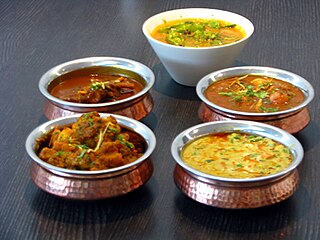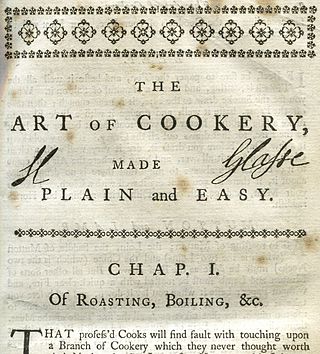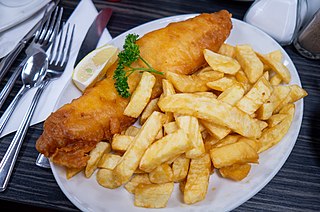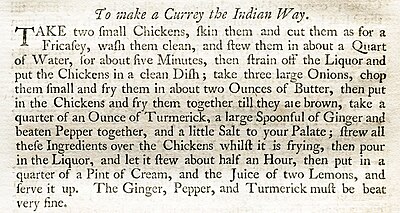
Curry is a dish with a sauce seasoned with spices, mainly associated with South Asian cuisine. In southern India, leaves from the curry tree may be included. Curry is also found in the native cuisines of many South East Asian and East Asian countries due to ancient contact with South Asia.

English cuisine encompasses the cooking styles, traditions and recipes associated with England. It has distinctive attributes of its own, but is also very similar to wider British cuisine, partly historically and partly due to the import of ingredients and ideas from the Americas, China, and India during the time of the British Empire and as a result of post-war immigration.

A chutney is a spread typically associated with cuisines of the Indian subcontinent. Chutneys are made in a wide variety of forms, such as a tomato relish, a ground peanut garnish, yogurt or curd, cucumber, spicy coconut, spicy onion or mint dipping sauce.
Indian cuisine consists of a variety of regional and traditional cuisines native to the Indian subcontinent. Given the diversity in soil, climate, culture, ethnic groups, and occupations, these cuisines vary substantially and use locally available spices, herbs, vegetables, and fruits.

A dosa is a thin, savoury crepe in South Indian cuisine made from a fermented batter of ground white gram and rice. Dosas are served hot, often with chutney and sambar. Dosas are popular in South Asia as well as around the world.

Kedgeree is a dish consisting of cooked, flaked fish, boiled rice, parsley, hard-boiled eggs, curry powder, butter or cream, and occasionally sultanas.

Chicken tikka masala is a dish consisting of roasted marinated chicken chunks in a spiced sauce. The sauce is usually creamy and orange-coloured. The dish was popularised by cooks from India living in Great Britain and is offered at restaurants around the world.

Mulligatawny is a soup which originated from South Indian cuisine. The name originates from the Tamil words miḷagu, and taṇṇi ; literally, "pepper-water". It is related to the dish rasam.

Tamil cuisine is a culinary style of Tamil people originating in the southern Indian state of Tamil Nadu and neighboring Sri Lanka. Meats, along with rice, legumes, and lentils, are also popular. Dairy products and tamarind are used to provide sour flavors. On special occasions, traditional Tamil dishes are served in a traditional manner, using banana leaves in place of utensils. After eating, the banana leaves are then used as a secondary food for cattle. A typical breakfast meal consists of idli or dosa with chutney. Lunch includes rice, sambar, curd, kuzhambu, and rasam.

The Art of Cookery Made Plain and Easy is a cookbook by Hannah Glasse (1708–1770) first published in 1747. It was a bestseller for a century after its first publication, dominating the English-speaking market and making Glasse one of the most famous cookbook authors of her time. The book ran through at least 40 editions, many of which were copied without explicit author consent. It was published in Dublin from 1748, and in America from 1805.

Kofta is a family of meatball or meatloaf dishes found in Balkan, Middle Eastern, North African, South Caucasian, South Asian and Central Asian cuisines. In the simplest form, koftas consist of balls of minced meat – usually beef, chicken, pork, lamb or mutton, or a mixture – mixed with spices and sometimes other ingredients. The earliest known recipes are found in early Arab cookbooks and call for ground lamb.

Hannah Glasse was an English cookery writer of the 18th century. Her first cookery book, The Art of Cookery Made Plain and Easy, published in 1747, became the best-selling recipe book that century. It was reprinted within its first year of publication, appeared in 20 editions in the 18th century, and continued to be published until well into the 19th century. She later wrote The Servants' Directory (1760) and The Compleat Confectioner, which was probably published in 1760; neither book was as commercially successful as her first.

Jalfrezi is a stir-fried curry dish originating in Bengal and popular throughout South Asia. Jalfrezi means "hot-fry". It consists of a main ingredient such as meat, fish, paneer or vegetables, stir-fried and served in a thick spicy sauce that includes green chilli peppers. Common further ingredients include bell peppers, onions and tomatoes.

Indian Chinese cuisine, Chinese Indian cuisine, Sino-Indian cuisine, Chindian cuisine, Hakka Chinese or Desi-Chinese cuisine is a distinct style of Chinese cuisine adapted to Indian tastes, combining Chinese foods with Indian flavours and spices. Though Asian cuisines have mixed throughout history throughout Asia, the most popular origin story of the fusion food resides with Chinese labourers of Calcutta, who immigrated to British Raj India looking for work. Opening restaurant businesses in the area, these early Chinese food sellers adapted their culinary styles to suit Indian tastes.

Veeraswamy is an Indian restaurant in London, located at 99-101 Regent Street. It was opened in 1926 by Edward Palmer, an Anglo-Indian retired British Indian Army officer, the grandson of an English general and an Indian princess. It is the oldest surviving Indian restaurant in the United Kingdom. In its early years, Veeraswamy served Anglo-Indian cuisine, but in recent decades, based on the popularity of authentic Indian food in the UK, has served a menu of regional Indian cuisine, including dishes from Punjab, Lucknow, Kashmir, and Goa. Edward Palmer used the name E. P. Veeraswamy for his food business and the book; Veeraswamy was his grandmother's family name. Initially it was spelled Veerasawmy, it became Veeraswamy because of a printing error.

British cuisine is the specific set of cooking traditions and practices associated with the United Kingdom, including the cuisines of England, Scotland, Wales and Northern Ireland. According to food writer Colin Spencer, historically, British cuisine meant "unfussy dishes made with quality local ingredients, matched with simple sauces to accentuate flavour, rather than disguise it".

Mrs Balbir Singh was an Indian chef, cookery teacher and cookbook author. Her formal cooking and homemaking classes began in New Delhi in 1955, and her award-winning Mrs Balbir Singh’s Indian Cookery book, was first published in London in 1961 to much acclaim and inspired future generations of Indian chefs and cookery authors.

Paneer makhani is an Indian dish of paneer, originating in New Delhi, in which the gravy is prepared usually with butter (makhan), tomatoes and cashews. Spices such as red chili powder and garam masala are also used to prepare this gravy.

Curry, a spicy Asian-derived dish, is a popular meal in the United Kingdom. Curry recipes have been printed in Britain since 1747, when Hannah Glasse gave a recipe for a chicken curry. In the 19th century, many more recipes appeared in the popular cookery books of the time. Curries in Britain are widely described using Indian terms, such as korma for a mild sauce with almond and coconut, Madras for a hot, slightly sour sauce, and pasanda for a mild sauce with cream and coconut milk. One type of curry, chicken tikka masala, was created in India, but has become widespread enough to be described as the national dish.


















